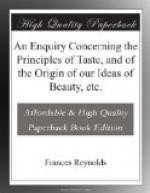The Augustan Reprint Society
Frances Reynolds
An Enquiry Concerning the Principles of Taste, and of the Origin of Our Ideas of Beauty, etc. (1785)
With an Introduction by James L. Clifford
Publication 27
Los Angeles
William Andrews Clark Memorial Library
University of California
1951
GENERAL EDITORS
H. Richard Archer, Clark Memorial Library
Richard C. Boys, University of Michigan
Edward Niles Hooker, University
of California, Los Angeles
John Loftis, University of California,
Los Angeles
ASSISTANT EDITORS
W. Earl Britton, University of Michigan
ADVISORY EDITORS
Emmett L. Avery, State College of Washington
Benjamin Boyce, Duke University
LOUIS I. BREDVOLD, University of Michigan
CLEANTH BROOKS, Yale University
JAMES L. CLIFFORD, Columbia University
ARTHUR FRIEDMAN, University of Chicago
SAMUEL H. MONK, University of Minnesota
ERNEST MOSSNER, University of Texas
JAMES SUTHERLAND, Queen Mary College, London
H.T. SWEDENBERG, JR., University of California,
Los Angeles
INTRODUCTION
Since the early nineteenth century it has been known that Frances Reynolds, the sister of Sir Joshua, was the author of an essay on taste, which she had printed but did not publish. Yet persistent search failed to turn up a single copy. It remained one of those lost pieces which every research scholar hoped someday to discover.
In 1935 it appeared that the search was over. Among some manuscripts of Mrs. Thrale-Piozzi, long hidden in Wales, was found a printed copy of an anonymous Enquiry Concerning the Principles of Taste, and of the Origin of Our Ideas of Beauty, which seemed to be the lost essay. The date was correct; the Enquiry was dedicated to Mrs. Montagu; it contained a quotation from Dr. Johnson; and, best of all, there was attached to the pamphlet a copy (in an unidentified handwriting) of Johnson’s well-known letter to Miss Reynolds concerning her essay.
Only one thing stood squarely in the way of the identification. James Northcote in his Life of Sir Joshua Reynolds, published in 1818 (II, 116-19), after describing Johnson’s connection with the manuscript, gives two pages of short excerpts. Most of the quotations are general statements such as “Dress is the strong indication of the moral character” or “The fine arts comprehend all that is excellent in the moral system, and, at the same time, open every path that tends to the corruption of moral excellence.” Unfortunately none of these excerpts appears directly in the Enquiry. Although some of the ideas are similar, the wording and specific details are different. By no stretch of the imagination could they be considered to come from the same piece. Thus Northcote blocked the solution of the mystery for nearly fifteen years.




